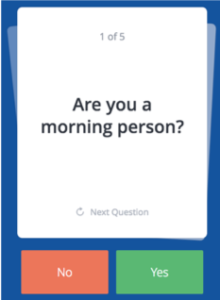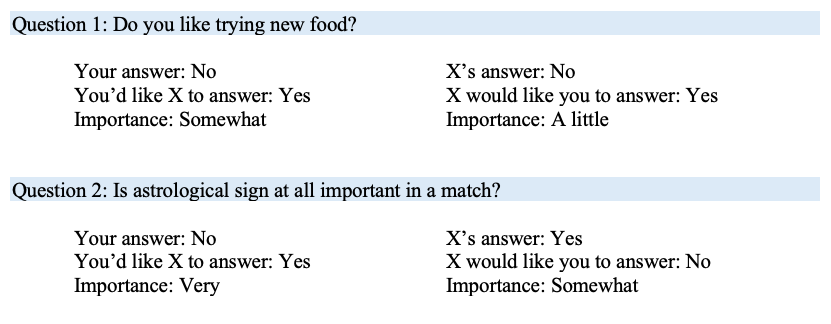The Art of Finding Your Soul Mate Five Key Elements
The Computation of Honey: Finding Your Soul Mate Online
Abstruse
In an historic period of technology and gratis Wi-Fi, those of us navigating the single life can opt for the electronic highway to love. Computer engineering has allowed guild to grasp the subjective nature of attraction and translate it into quantitative data that computers can understand and procedure. Matching algorithms take the guess work out of dating with their belittling arroyo to honey.
The Single Life of an Engineer
Of course I savor the holidays. What's not to love? Festive feasts, family bonding, and unending comments from a distant aunt about the fact that I'thou not seeing anyone. Like many of my peers, I've been badgered far too oft with pointed queries concerning my dating life. In these circumstances I am forced to consider the age old question: Why am I single?
I like to believe that it's not an outcome of personality, but rather numbers. There are currently almost 323,815,107 people living in the United States. Since my current transportation options effectually Los Angeles are limited to metros and bicycles, let's scrap that number down to the 3,928,827 people living in the urban center. Of that population, 59% are single, fifty% are male, 32% have a Available'south or Mail service-grad caste, and 17% are between the ages of 20 and 29. Nosotros're left with about 63,050 "eligible bachelors" [1]. That'south plenty, right? Sure, merely let'due south now venture into the murky waters of animalism and honey. Empirically speaking, I'll say I'm attracted to roughly twenty% of the people I meet. I'll assume that twenty% of that group shares a mutual allure. two,522 bachelors. Is he straight? Does he similar trying new things? Is he a nice person? Permit'south be frank. As my list of ethics grows, my cutting of potential soulmates narrows.

And I'g non the only one feeling this pressure. The difficulty of finding a partner is relevant across demographics and generations. Many of the states tin chronicle to the touch of fleeting desperation that graces the single life. In fact, this hitch has awakened the engineer in all of united states of america. The dawn of online-dating is the noon of human beings doing what we've always done– analyze the tools around us and ask how nosotros can utilise them to amend our circumstances. In this case, we've used mass media and communication technology to help ourselves cast a cyberspace for dearest, sex, and companionship [2].
Algorithms, Analysis, and Allure
For those unfamiliar with estimator technology, the concept of algorithms may seem daunting. All the same, they can be only explained as a systematic, step-by-step approach to trouble solving. Similar to how a recipe book uses sentences to explain how to make a meal, computers utilize algorithms to complete a task. These tasks range from connecting a device to Wi-Fi to predicting trends in the stock marketplace.
We'll focus on the use of algorithms for online-dating websites. These algorithms serve as digital matchmakers determining the potential success for two individuals to have a satisfactory first date. For many matchmaking websites, the algorithms used to match individuals are heavily guarded. However, ane website, OkCupid.com, uses a relatively simple algorithm and has openly published information on its awarding. This overview will serve every bit a bones introduction to the world of similar algorithms utilized by other online-dating websites.

The real challenge for those engineers building matching algorithms is to effigy out how to take something equally subjective as homo attraction and translate it into components that a computer can process and analyze. The get-go step in quantifying human attraction is to collect information concerning an private'due south personality. The best way to collect this data is, well, to ask for it. Once a user creates a profile on OkCupid.com, he or she is given a ready of yes-or-no calibration questions. Are you a forenoon person? Practice you lot like scary movies? Would you take sexual practice on the showtime date? Many of the randomly dispensed questions are useful for matching "like with like." In other words, the algorithm assumes that 2 people who answer a question in the same way will get along. For example, two individuals who believe in God are probably a better match than a devout Christian and an atheist.
Just what about questions similar: Practice y'all like to be the center of attention? If an algorithm simply matched "like with like," and both individuals in that match answered yes, they might have an outcome sharing the spotlight and would not make a great pair. Another concern is that not all questions are equal. A question regarding the ethics of abortion reveals more about an individual than his or her movie preference, and you're more likely to overlook a deviation in genre preference rather than alien upstanding mores. To resolve this glitch, the OkCupid algorithm includes three layers to each question: users are asked to (i) requite their own response, (ii) indicate how they would like a partner to respond, and (iii) rank the level of importance that question plays in their life.
It Takes Two
Imagine yourself as a current OkCupid user. Welcome to the world of virtual dating! Your match per centum with some other user, let'south call them "X," is based on questions y'all've both answered. We'll walk through an example where ii users, y'all and Ten, have answered two yes-or-no questions:

Take a moment to go over the responses to each question listed above. Since computers will be analyzing this data, numerical values must be assigned to variables such as degree of importance. These numerical values volition eventually be used to calculate a percent lucifer between you lot and X. OkCupid gives users the selection to charge per unit a question on a scale of "a little" to "somewhat" to "very" important. A question rated every bit "a little" important is weighted with one signal. "Somewhat" and "very" important questions are weighted with 10 and 50 points, respectively. Briefly, if X responds to a question with the answer yous'd like a friction match to have, X has answered correctly and receives the full point value for that question.

Let'southward begin with your satisfaction rating of X. You lot chose to weight question 1 and 2 every bit "somewhat" and "very" important, leading to a total of lx possible points that X tin can score. Ten answered question 1 incorrectly , in this case significant that the respond is not what you would similar a match to requite. And then far Ten has lost out on 10 out of 60 points. Fortunately, Ten provided the correct answer for question 2, which yous weighted as "very" of import. X ends with a total of l out of 60 points, computing as an 83% satisfaction rating.
Now let'southward determine X's satisfaction rating of you. Ten weighted question 1 and 2 as "a little" and "somewhat" important, creating a total of 11 possible points. You provided the wrong answer for question one just the correct answer for question 2. Your score of 10 out of 11 results in a 91% satisfaction rating.
To determine the percent match betwixt you and X, nosotros will take the geometric hateful of the ii satisfaction ratings calculated above. Geometric mean is an average that indicates the central tendency (the typical value) in a set of numbers. The math from here is elementary. The ii satisfaction ratings are multiplied and the northward th root, where n = number of questions, of the product is taken. In the case in a higher place, north = 2. Consequently, the square root of the product of 83 and 91 is calculated. The resulting percent friction match betwixt yous and X is 86%. This percentage represents the likelihood that the two of yous would have a satisfactory beginning engagement. Not bad for two questions! Because the margin of fault decreases as due north increases, ii users who opt to respond more questions will be given a more accurate pct match.
The geometric mean is useful for calculating romantic matches because it accounts for a wide range of topics, interests, and data points such as movies, politics, and religion. Intuitively, the calculation makes sense. It makes sense that two individuals each with a l% satisfaction rating should be a better match than two others who satisfy each other 0% and 100% respectively because affection must be mutual in a successful human relationship [three].
Seems easy, correct? The steps nosotros walked through simply now are mirrored by the algorithm used by OkCupid.com on a larger scale. With data points and uncomplicated calculations, online-dating algorithms have the ability to digest qualitative aspects of attraction and translate that information into quantitative data that a microchip can procedure and empathize.
Hacking Your Fashion to Love

I'yard non about to tell you that in that location is a wrong way to date online. After all, most of online-dating involves you lot talking near yourself and information technology's hard to exist completely off-base when answering a questionnaire. Nevertheless, it is possible to optimize your dating contour to concenter the kind of users you know you would be interested in if you lot had met them offline.
Chris McKinlay, a 35-yr-erstwhile mathematics PhD candidate, was no stranger to online dating. Despite the numerous, charming introductory messages he sent out, he had yet to find "The One." Speaking specifically to his success on OkCupid, McKinlay realized that the questions he had answered at random were non improving his chances of finding a mate. OkCupid'south algorithm relies on questions answered past both individuals. He realized that in gild to be more than successful on these dating websites that he would take to opposite-engineer his profile.
Through statistical sampling, McKinlay was able to make up one's mind which questions were being answered by the women he liked. He set upwardly 12 false OkCupid accounts and wrote a Python script that would search his target demographic and collect all information provided on their contour page including acme, race, astrological sign, and age. Users are only able to come across questions that both parties have answered, so McKinlay programmed 12 fake accounts to answer questions randomly and collect data. After three weeks of information scraping, he had collected over 6 million questions and answers from women across the Us.
By modifying a Bell Labs algorithm, which was originally used to analyze diseased soybean crops, McKinlay was able to clump the women he "surveyed" into seven statistically singled-out clusters based on their questions chosen and answers provided on OkCupid. McKinlay decided to pursue two clusters of women: the first was dominated by younger indie-type musicians and artists, the 2d by mid-thirties women with professional creative jobs.
McKinlay used text analytics to rummage through profiles of the 2 clusters to learn what interests were trending within each cluster. He then created 2 separate, genuine profiles of himself that focused on those golden topics. At this indicate he was optimizing his original profile to highlight aspects that specific demographics would be attracted to.
The most important aspect of these ii new profiles, nonetheless, was the questionnaire. McKinlay answered each question honestly, but used a machine-learning algorithm called adaptive boosting to decide how much importance to assign to each question. As nosotros saw in the walk-through case with two questions, the amount of importance y'all place on a question can dramatically alter your satisfaction ratings.
McKinlay's reverse-engineering of his dating profile proved to be an phenomenal success. He was raking in matches and became the Gilt Boy of online dating. The pages and pages of high percentage matches proved that by creating online-dating profiles with an engineering perspective, the oversupply of potential mates drawn in can completely change. He was the same guy– merely packaged differently!
A Happy Ending
Whether or not you decide to venture into the globe of online dating, it'due south important to recognize the strides that nosotros have made as a gild. Together we have engineered a novel method of advice that utilizes the internet and makes the globe a smaller place. It simply makes sense that in this historic period of light-speed communication that we would employ the net as a tool to hustle along our search for honey. And the best part? Every individual gets to determine whether he or she will allow fate take its fourth dimension or if they'd rather allow algorithms exercise the dirty work and but bask the ride. A sometimes disregarded caveat, even so, is that these algorithms exercise not carry a relationship. One time the match has been fabricated, it'south upwards to those two individuals to go along the spark going. Every bit for me, I'm still looking for that soul mate of mine who'south roaming about Los Angeles. And who knows, maybe I'll find him online. ■
Works Cited
[1] Census Reporter. (2016, June xix). Los Angeles, CA. [Online]. Available: https://censusreporter.org/profiles/16000US0644000-los-angeles-ca/
[ii] Susie Lee. (2016, June 21). The History of Online Dating from 1695 to At present . [Online]. Available: http://www.huffingtonpost.com/susie-lee/timeline-online-dating-fr_b_9228040.html
[3] Christian Rudder. (2016, June twenty). Inside OkCupid: The math of online dating . [Online]. Available: https://www.youtube.com/spotter?v=m9PiPlRuy6E
All figures are taken directly from okcupid.com.
Source: https://illumin.usc.edu/the-computation-of-love-finding-your-soul-mate-online/
0 Response to "The Art of Finding Your Soul Mate Five Key Elements"
Post a Comment